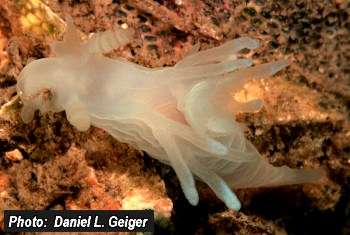
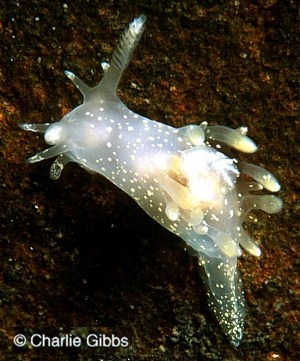
Ancula gibbosa
(Risso, 1818)
Order: NUDIBRANCHIA
Suborder: DORIDINA
Superfamily: ANADORIDOIDEA
Family: Goniodorididae
DISTRIBUTION
From the western Mediterranean around the northern Atlantic coast to the White Sea, Greenland & Iceland and across the New England coast of N. America. If A. pacifica is the same species it also occurs on the west coast of North America.
PHOTO
UPPER RIGHT: Mumbles, Swansea, Wales, United Kingdom, March 1993. Specimens found at low tide (0.1m) on larger stones in lowest Fucus serratus belt. PHOTO: Daniel Geiger.
LOWER RIGHT: White-spotted colour form, Vancouver, British Columbia, Canada. PHOTO: C. Gibbs.
Grows to about 30mm. Translucent white, usually with three longitudinal orange lines on body and orange tipped rhinophores, gills and papillae. Rarely, as in this photo, the orange is replaced with opaque white. Usually found on compound bryozoans but Picton, on his website, suggests they may in fact feed on Entoprocta [= Kamptozoa], minute animals thast can be found living on bryozoans and other sessile animals. Ancula pacifica from west coast of North America is identical in colour and Thompson (1976) considers it a synonym of A. gibbosa.
See my comments below.
See message on white-spotted colour form.
See message on Ancula pacifica.
Reference:
• Risso, A. (1818). Memoire sur quelques gasteropodes nouveaux, nudibranches et tectibranches observes dans la mer de Nice (1). Journal de Physique de Chimie, d'Histoire naturelle et des Arts, Paris 87: 368-377.
Rudman, W.B., 2000 (March 24) Ancula gibbosa (Risso, 1818). [In] Sea Slug Forum. Australian Museum, Sydney. Available from http://www.seaslugforum.net/find/ancugibb
Related messages
Ancula gibbosa from California
May 31, 2007
From: Clinton Bauder

Hi Bill,
This is another new one for me. I gather it's called Ancula gibbosa now. This is the "A. pacifica" color variation.
Locality: Point Lobos State Reserve, 12 meters, CA, USA, Pacific, 22 May 2007, Rocky Reef. Length: 20mm. Photographer: Clinton Bauder.
Clinton
gecko1@apple.com
Bauder, C., 2007 (May 31) Ancula gibbosa from California. [Message in] Sea Slug Forum. Australian Museum, Sydney. Available from http://www.seaslugforum.net/find/19951Hi Clinton,
Yes, you are correct. I am amazed at the variablity in coloration of his species. Your critter is what I have called "A. pacifica" for years.
Thanks for sharing this one,
Dave Behrens
Re: Ancula from NE Pacific
June 3, 2006
From: Jan Kocian
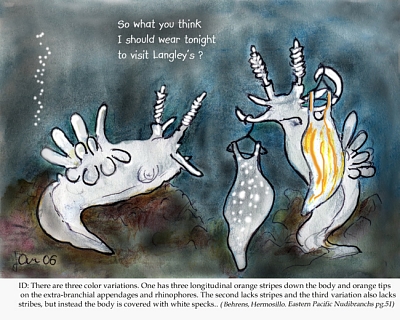
Concerning message #16750:
Hello Bill,
Not so serious follow up on the Ancula post, .. Thanks for your kind guidance through my slug world.
Jan
honkoc@hotmail.com
Kocian, J., 2006 (Jun 3) Re: Ancula from NE Pacific. [Message in] Sea Slug Forum. Australian Museum, Sydney. Available from http://www.seaslugforum.net/find/16765Dear Jan,
Your 'not so serious' contributions are always welcome
Best wishes,
Bill Rudman
Re: more Ancula from NE Pacific
June 1, 2006
From: Jan Kocian
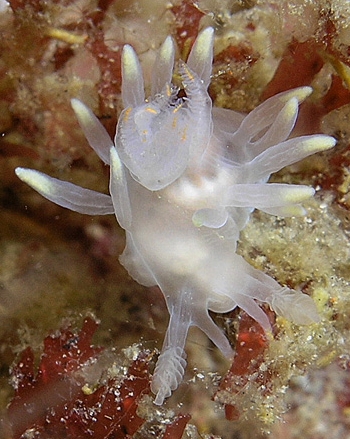
Concerning message #16657:
Hello Bill,
A few days ago I saw photos of Ancula on the Forum and since they were taken at a locality where I frequently dive, I could not resist to go and try to find the slug myself, since I never saw it before. In spite of very poor visibility we experiencing lately, I managed to find four individuals, at the same location, but unlike Bill Hevener's photos, two of these have white specks. Also note the infestation by parasites commonly found here on Janolus fuscus.
Locality: Langley Tire Reef, 35 feet, Washington, USA, Puget Sound, NE Pacific Ocean, 29 May 2006, artificial reef. Length: 14 mm. Photographer: Jan Kocian.
Best regards,
Jan
honkoc@hotmail.com
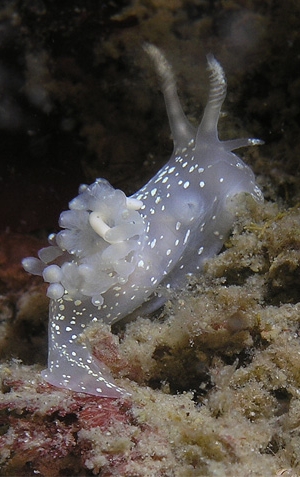
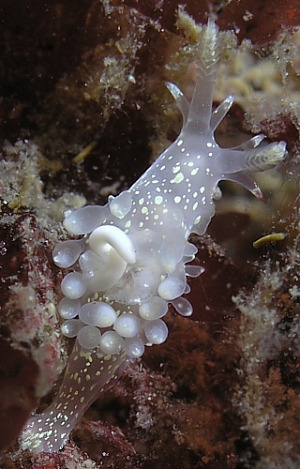
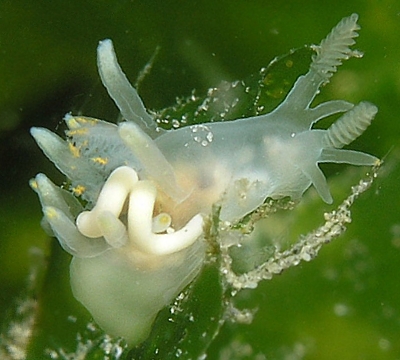
Dear Jan,
This is certainly a 'species' which needs some work. Your non-spotted animals clearly show the yellow lines on the tips of the gills. The two white-spotted animals seem to have a double row of lateral papillae behind the gills. Other photos of this colour form on the Forum don't have this double row, so it must be a peculiarity of these animals rather than of this colour form.
It's interesting to see that the parasitic copepods infect both colour forms. In fact I noticed the white lump in the gill region of Bill Hevener's animal and wondered if it was a parasite. Your photos certainly confirm it most surely was.
For those of you not familiar with copepod parasites in nudibranchs, have a look at the parasite page for some links. In Jan's photos, the large curved white 'sausages' are the egg sacs of crustacean parasites, the body being inside the nudibranch.
Best wishes,
Bill Rudman
Ancula from NE Pacific
May 29, 2006
From: William Hevener
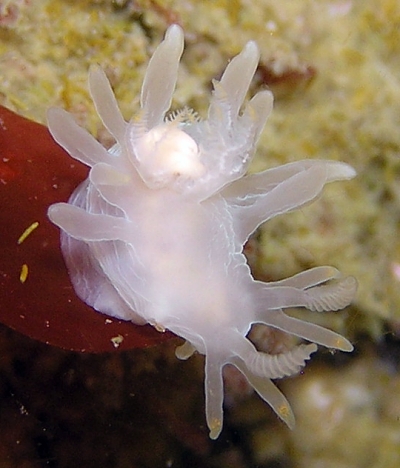
Attached is a picture of a nudibranch that I have neither seen nor been able to identify via the web or books. Any assistance would be greatly appreciated.
Locality: Langley, 37 feet, WA, USA, Pacific Ocean, 14 May 2006, Tidal, Shore, Sandy Bottom. Length: 14 mm. Photographer: William H. Hevener.
V/r,
Bill Hevener
william.hevener@navy.mil
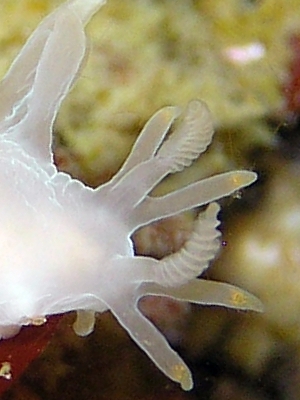
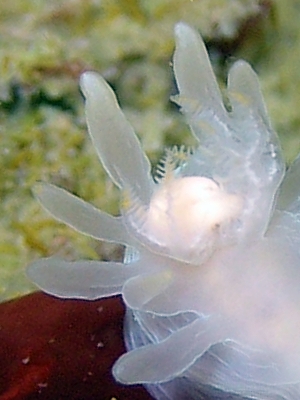
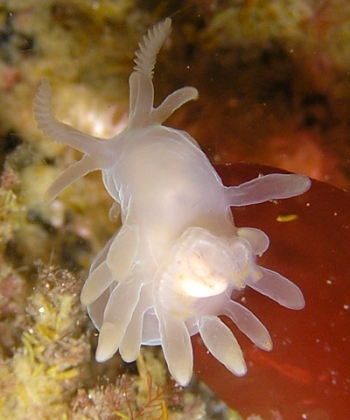
Dear Bill,
This is part of the Ancula puzzle. Species from both the northern Pacific have been idnetified as Ancula gibbosa but some with distinct yellow lines, from the nthn Pacific have been distinguished as Ancula pacifica. At present I have them all together on the Ancula gibbosa page. Looking carefully at your photos I can see traces of yellow on the papillae around the edge of the body and on the gills which might suggest a link between the pale translucent white forms and the yellow-lined A. pacifica forms.
Interestingly, your animal is closest in colour to one in Alan Shepard's message [#8883] from the Atlantic coast of Nth America.
Best wishes,
Bill Rudman
Spotted Ancula from eastern Russia
January 13, 2006
From: Alexei Chernyshev
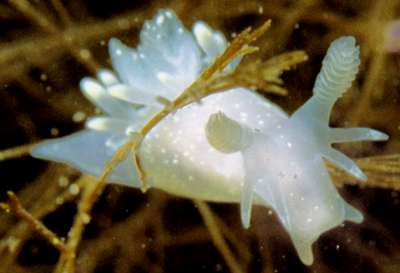
Dear Bill,
Alexei Shpatak photographed a single specimen of the colorless goniodoridid (or polycerid ?) in Olga Bay (Japan Sea). Can you help me know the generic and specific name of this nudibranch?
Locality: Olga Bay, Russia. Japan Sea. Depth: 3-5 metres. Length: about 15 mm. August 2005. among algea and hydroids. Photographer: Shpatak A.
Sincerely yours,
Alexei
[for Chernyshev, AV., & Shpatak A.]
tsher@bio.dvgu.ru
Chernyshev, A.V. & Shpatak A. , 2006 (Jan 13) Spotted Ancula from eastern Russia. [Message in] Sea Slug Forum. Australian Museum, Sydney. Available from http://www.seaslugforum.net/find/15532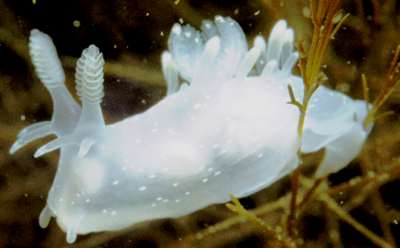
Dear Alexei,
This is an interesting find. If you have a look at the Ancula gibbosa Fact Sheet you will see there is a continuing discussion on just how many species there are within this group. In particular, have a look at the following messages: #14037; #14220; #2404, which all illustrate a white-spotted animal which must surely be the same as yours.
Best wishes,
Bill Rudman
Ancula pacifica from South Korea
July 16, 2005
From: Dong Bum Koh
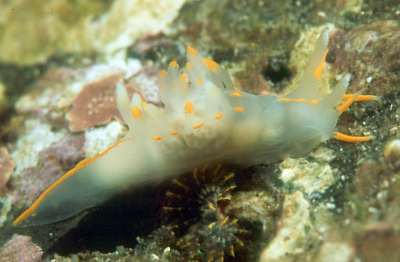
Dear Bill,
Concerning the message (#2546 )
This is a photo of what I think is Ancula pacifica from South Korea.
Locality: Sa Soo fishery Harbor. Jeju Island. South Korea. Depth: 5 m. Length: About 20 mm. 16 June 2004. Rocky bottom. Photographer: Byung Ro Youn
Best regards,
Dong Bum Koh
drkoh@seasee.co.kr
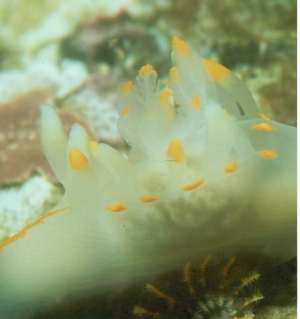
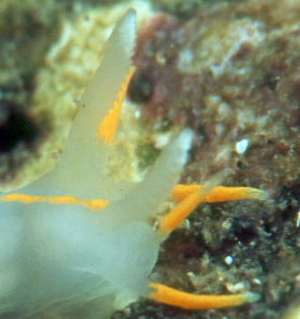
Dear Koh,
Thanks for this. Has this species been previously recorded from the NW Pacific? I thnik the time has definitely arrived for me to split the animals up on this page into a number of separate species - or at least colour forms.
Best wishes,
Bill Rudman
Spotted Ancula from NE Pacific
July 11, 2005
From: Sandra Millen
Hi Bill,
Concerning Paul Sim's message #14037:
I have looked a little at the spotted Ancula, including doing some SEM's. It does appear to have some differences, but I have never had the Atlantic species to compare it to. In British Columbia those with and without white spots are found together, but we do not have the lined one which is further south. One of those things I must get back to someday or someone can take up as a good project.
Sandra Millen
millen@zoology.ubc.ca
Millen, S., 2005 (Jul 11) Spotted Ancula from NE Pacific. [Message in] Sea Slug Forum. Australian Museum, Sydney. Available from http://www.seaslugforum.net/find/14220Thanks Sandra,
Bill Rudman
Ancula pacifica from Vancouver, Canada
June 13, 2005
From: Paul Sim
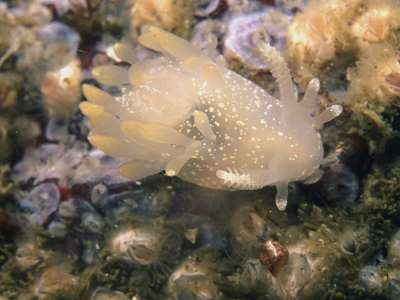
Here are a couple more shots of our version of this beautiful creature. They were very numerous on this particular wall at this particular time of the year. Later, we won't see them at all. Where do they go?
Locality: Woodlands Wharf, Indian Arm, Burrard Inlet, Vancouver, BC, Canada. Pacific. Depth: 50 feet. Length: 3/8 inch. May 11, 2005. Wall dive. Photographer: Paul Sim
Paul Sim
plsim@shaw.ca
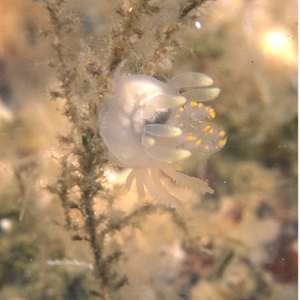

Dear Paul,
Thanks for these photos of 'Ancula pacifica'. Firstly I find it very difficult to believe the spotted and yellow-lined animals are really both the same species, and also that either of them are the same as the Atlantic A. gibbosa. Although I have put all these colour forms together on the one Fact Sheet, I suspect some anatomical work might show suggest they should be splits.
Concerning where do they go when you can't find them. Most small nudibranchs live for less than a year, and most have planktonic larvae which swim or drift around in the water for part of their life cycle. If the species is particularly seasonal, absence could mean it is in its larval stage. Since larvae are at the mercy of currents etc, there is no guarantee that a particular species will be found at a particular spot each year. For short lived species - living less than a year - we think the species moves around from place to place by the adults producing larvae at one place, which then drift to another place where they find the right food, settle and grow to adulthood. These adults then produce larvae which float away and the cycle begins again. For species such as the one you describe here which seem present each year at the same spot, its possible the larvae are dependent on a cycle of temperature and currents which combine to bring back the right conditions each year for the species to thrive. Usually these 'regular returns' are not as clockwork as they appear, but diligent sampling and recording of species is very time-consuming and for that reason is seldom undertaken. Longterm regular recording is the sort of thing dive clubs around the world sometimes undertake, but it takes a great degree of committment by the participants and has to be done for some years.
Best wishes,
Bill Rudman
Re: Supplement to Pacific Coast Nudibranchs
July 23, 2004
From: Joao Pedro T. L. S. Silva
Concerning Dave Behren's supplement [m12698]: Although I'm not planning on going anywhere in the Pacific, I found this paper a very interesting reading. One thing puzzled me: the animals on photo D of the Plate 3 are identified as Ancula gibbosa. It looks just like Polycera quadrilineata (at least the specimens I've seen). What are the distinguishing characteristics?
PS: it's great to see the Forum in back on the move!
All the best,
Joao Pedro
jpsilva@uwphotographer.net
Silva, J.P., 2004 (Jul 23) Re: Supplement to Pacific Coast Nudibranchs. [Message in] Sea Slug Forum. Australian Museum, Sydney. Available from http://www.seaslugforum.net/find/12701Dear Joao Pedro,
If you have a look at the page on Ancula gibbosa you will see there is some discussion on whether it occurs on the west coast of Nth America. However the most obvious external difference between the two is that A. gibbosa has three or four lateral papillae on each side of the gill circle while the P. quadrilineata has only one
Best wishes
Bill Rudman
Ancula gibbosa from Massachusetts, USA
January 13, 2003
From: Alan Shepard
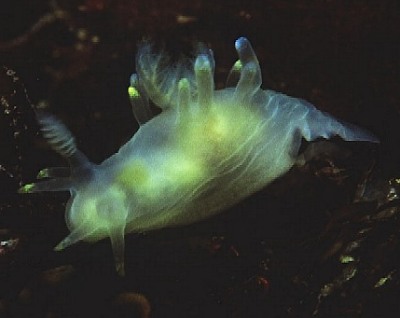
Bill -
Here's another species of nudibranch that appears in New England when the waters turn colder. It is Ancula gibbosa. We don't see a great many of these but they are common enough that every few dives in the winter one or two will turn up.
I actually have a question that finding this nudibranch raised. I was actually photographing the Doto sp., I just sent in a separate message, when out of the corner of my eye I saw a small nudibranch floating by. Quite often you see Palio dubia floating around so this wasn't a surprise. Anyway something told me this was not Palio dubia so I gently guided it down to the boulder where the Doto was and was happy to see it was an Ancula.
The question seeing it floating raised is do any nudibranchs detach themselves purposefully and drift to areas for more food or is detachment just accidental? The reason I ask is it is very common to see Palio dubia floating around, almost too common to just be accidental.
Thanks,
Alan Shepard
Tolland, CT, USA
alan.chepard@snet.net
Shepard, A., 2003 (Jan 13) Ancula gibbosa from Massachusetts, USA. [Message in] Sea Slug Forum. Australian Museum, Sydney. Available from http://www.seaslugforum.net/find/8883Thanks Alan,
Concerning 'drifting' as a means of dispersal. I did start up a page on the topic but have not had many comments. One which seems very relevant was from Jussi Evertsen and concerned Polycera floating, much as you describe, in northern Europe in Autumn and Winter. It is also that another polycerid, the tropical Kalinga ornata, is also reported to float [see messages from Hawaii and eastern Australia].
Ancula gibbosa from New England
March 20, 2002
From: Alan Shepard

Bill -
I noticed that you did not have a photo of Ancula gibbosa from New England. I have been searching for it for a couple years now and finally encountered a couple just this past week. The one pictured was only about one-half inch long. It was relatively close to shore in only 12 feet of water. On the same dive I encountered one other specimen that was even smaller. I'm hoping to capture more photos of what seems to be an elusive nudibranch here in New England.
Regards,
Alan Shepard
aetobatus@aol.com
Shepard, A., 2002 (Mar 20) Ancula gibbosa from New England. [Message in] Sea Slug Forum. Australian Museum, Sydney. Available from http://www.seaslugforum.net/find/6458Thanks Alan,
It would certainly be interesting to know how much colour variation is present on the wast coast of North America. And for that matter any information on its food, egg mass etc would be of great interest.
Best wishes,
Bill Rudman,
Colour variation in Ancula gibbosa
March 6, 2001
From: Bernard Picton
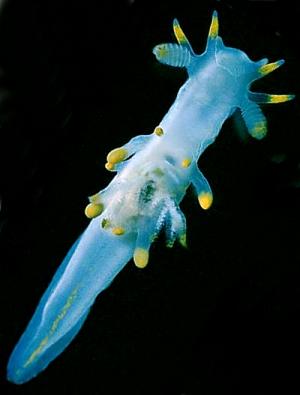
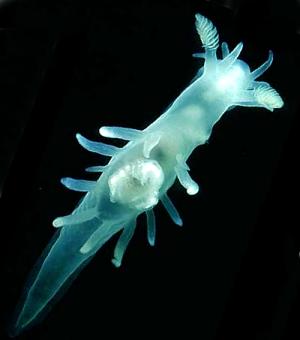
Hi Bill,
I see there is some debate over Ancula gibbosa and A. pacifica, and whether A. gibbosa occurs on the Pacific coast of North America. I enclose pictures of:
UPPER PHOTO: typical A. gibbosa with yellow markings (Millisle, Co. Down, Nthn Ireland) and
LOWER PHOTO: aberrant white form (Kilroot, Belfast Lough) without these markings. The
latter is already represented by Daniel Geiger's picture from Swansea.
I see also that you say Bernard Picton says Ancula feeds on minute animals living on bryozoans - actually I used the name kamptozoans which is a synonym of Entoprocta - so I agree with your conclusions about the food of
Ancula pacifica. I prefer to use Kamptozoa as I get confused between Entoprocta and Ectoprocta - Both used to be in the Phylum Polyzoa (Bryozoa) so Ectoprocta now = Bryozoa - confused yet?
In my earlier messages I have shown that species of Trapania also feed on Entoprocts (Kamptozoans).
Bernard
bernard.picton.um@nics.gov.uk
Picton, B., 2001 (Mar 6) Colour variation in Ancula gibbosa. [Message in] Sea Slug Forum. Australian Museum, Sydney. Available from http://www.seaslugforum.net/find/3910Thanks Bernard,
Firstly on feeding. I should have been more precise, 'minute animals' is not very informative. Considering that you have shown that Trapania also eats them [Entoprocta, Kamptozoa], they are definitely important enough to be named so I have changed the reference at the top of the page.
The more photos I see of Atlantic animals the more I wonder if Ancula pacifica is really the same species. The anatomy and radula seem quite similar, but these characters may not be useful in distinguishing species in this genus.
Are Thompson & Brown (1984) the only ones who have considered these species to be synonymous? They say: "Specimens found along the Californian coast, described under the name Ancula pacifica MacFarland, 1905, have extra pigment patches on the dorsum, but apparently lack other morphological differences"
If this is the only argument in favour of synonymising them, it doesn't seem very convincing to me. I would be grateful for anyone else's views or information.
Best wishes,
Bill Rudman
Re: Ancula pacifica feeding photos
June 29, 2000
From: Jeff Goddard
Hi Bill,
Regarding your comments on Bruce Wight's photo of Ancula pacifica feeding. Those are indeed the "heads" or calices of the entoproct Barentsia surrounding the Ancula. However, your left arrow in the upper photo appears to be pointing to a bryozoan lophophore; entoprocts generally do not have such long tentacles.
As to what the Flabellina in the photo is feeding on, there appear to be a few hydroid polyps (possibly Garveia sp.) directly in front of the aeolid. To my knowledge, no aeolids are known to feed on entoprocts.
All of this goes to show how careful we need to be in determining the prey of nudibranchs. Many of their prey are minute and occur in mixed company. Occurrence on or among suspected prey is the first step, followed by direct observations of feeding in the field or lab and (or) examination of gut contents. Sometimes consistent association with the suspected prey, combined with clear signs of feeding (fresh gouges into a sponge, missing polyps, empty zooecia, etc.), can be enough to confirm feeding.
Best wishes,
Jeff
goddard@lifesci.ucsb.edu
Goddard, J., 2000 (Jun 29) Re: Ancula pacifica feeding photos. [Message in] Sea Slug Forum. Australian Museum, Sydney. Available from http://www.seaslugforum.net/find/2635Dear Jeff,
I couldn't agree more with your comments about caution in determining food items. Concerning the object the left arrow is pointing to. I think the oblique angle of the photo makes the tentacles look much longer on the near side of the ring than they really are, but I am happy to defer to your local knowledge.
Bruce's photos of both Ancula and Flabellina trilineata are a great example of how valuable a contribution divers and photographers can make to our knowledge of these spectacular animals.
Best wishes,
Bill Rudman.
Ancula pacifica feeding
June 28, 2000
From: Bruce Wight
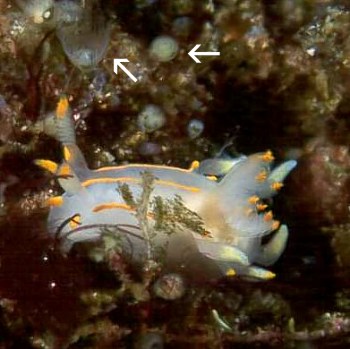
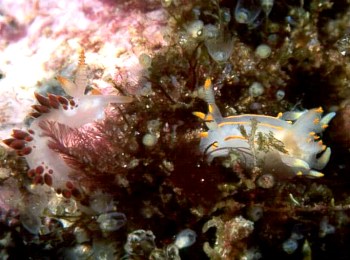
Hi again Doc.
Regarding the question as to what Ancula pacifica eats, I see them feeding on hydroids. Attached are photos of Ancula pacifica and juvenile Flabellina trilineata eating at the same table on a smorgasbord of some type of hydroid.
Hope you enjoy the images,
Take care
Bruce Wight
bwproductions@earthlink.net
Wight, B., 2000 (Jun 28) Ancula pacifica feeding. [Message in] Sea Slug Forum. Australian Museum, Sydney. Available from http://www.seaslugforum.net/find/2629Dear Bruce,
I don't know why I didn't check the wonderful List of the Worldwide Food Habits of Nudibranchs by Gary McDonald & James Nybakken at http://www2.ucsc.edu/people/mcduck/nudifood.htm when I asked you about their food.
In it, they list the food of Ancula pacifica to be Barentsia ramosa (Robertson), which is a member of the Phylum Entoprocta, which superficially look quite like hydroids. I suspect the animal in your photo, which I have arrowed, are entoprocts rather than hydroids. The Entoprocta are a small group of animals which used to be considered part of the Bryozoa [which are also known as Ectoprocta].
If I am right, I am not sure whether that means that your juvenile Flabellina trilineata are feeding uncharacteristically on entoprocts, or whether there are also small hydroids around as well.
It is also interesting to note in McDonald & Nybakken's list that Ancula gibbosa from Europe [as A. cristata] is reported to feed on hydroids and compound ascidians, although, as I note at the top of the page, Bernard Picton thinks it may feed on some animal that lives on compound ascidians.
If there is a good distinction between A. gibbosa and A. pacifica in feeding behaviour, then that it is useful evidence to suggest they are different species.
Perhaps someone from your part of the world will recognise the 'hydroid' or 'entoproct' in your photo.
Best wishes,
Bill Rudman.
Ancula pacifica mating
June 20, 2000
From: Bruce Wight
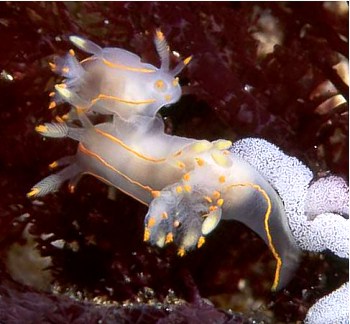
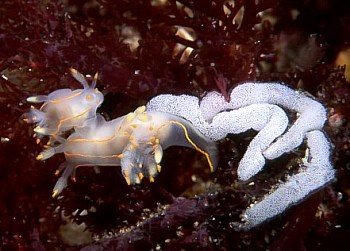
Hi Bill,
Glad you could use my photo that Dave sent you. No "r" in my last name though, just "Wight". Dave suggested I send you another photo, taken in Sept 1996 at San Clemente Island, of two animals of Ancula pacifica mating and with an eggmass. My wife and I have see hundreds of these branchs in the waters off Southern California and they have always had the three distinctive stripes.
Mike Miller uses them every now and again for his Slug Site. See our latest at http://siolibrary.ucsd.edu/slugsite/nudwk188.htm.
Take care,
Bruce Wight
bwproductions@earthlink.net
Wight, B, 2000 (Jun 20) Ancula pacifica mating. [Message in] Sea Slug Forum. Australian Museum, Sydney. Available from http://www.seaslugforum.net/find/2600Dear Bruce,
Thanks for the interesting photos. Sorry we got your name wrong. I'm seriously thinking of separating the different colour forms of Ancula on to separate pages so these beautiful photos aren't hidden. Do we know what this animal eats. It would be nice to have a photo of it feeding or on its food.
Best wishes,
Bill Rudman.
Ancula pacifica in Oregon and Washington
June 12, 2000
From: Jeff Goddard
Concerning the recent messages about Ancula pacifica in the northeastern Pacific. Specimens from Oregon consistently fall into two color forms:
• one with orange lines on the body (this is the one described by MacFarland and depicted in both Behrens (1991) and in Dave Behrens recent message in the Forum);
• one lacking the orange lines on the body (but, like the first form, possessing orange tipped rhinophores, accessory rhinophore papillae, gills and extrabranchial papillae). The second form is more common in Oregon and Washington, and as pointed out by Sandra Millen in this Forum, is the only form with orange pigment in British Columbia and Alaska. I have not seen the white spotted form in northern California, Oregon or Washington.
The form lacking the orange lines on the body is closest externally to Ancula gibbosa depicted by Thompson & Brown (1984), and my first guess is that they are the same species. I can't wait to hear about the results of the anatomical comparisons.
Jeff Goddard
goddard@lifesci.ucsb.edu
Goddard, J., 2000 (Jun 12) Ancula pacifica in Oregon and Washington. [Message in] Sea Slug Forum. Australian Museum, Sydney. Available from http://www.seaslugforum.net/find/2550A photo of 'typical' Ancula pacifica
June 11, 2000
From: Dave Behrens
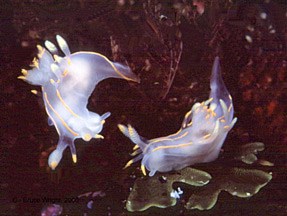
Dear Bill:
You have been looking for a photo of the more typical "yellow lined" color of Ancula pacifica MacFarland, 1905 to add the Forum. I have finally tracked down this fantastic photo taken by Bruce Wight at San Clemente Island, California, in October 1996.
Bruce's photo represents what most of us believe is a typical A. pacifica, based upon its original description from this coast. This species differs dramatically in its external features from the recently collected individuals in the Vancouver, B.C. area, posted on the Forum, as A. gibbosa.
We now have specimens and a close internal look will answer the identify question.
Dave Behrens
Dave@seachallengers.com
Behrens, D., 2000 (Jun 11) A photo of 'typical' Ancula pacifica. [Message in] Sea Slug Forum. Australian Museum, Sydney. Available from http://www.seaslugforum.net/find/2546Dear Dave,
Thanks for the photos. Marli Wakeling said she was sending you some specimens of the colourless form. Good to see the Forum helping to solve another little problem. I suppose it is possible that the European A. gibbosa, the white-spotted animal, and A. pacifica are all distinct species. It will be interesting to see what you find.
To remain unbiased on the question I'll temporarily leave Ancula pacifica and the colourless form together on the A. gibbosa page, but I'll put both names in the Species List.
Best wishes,
Bill Rudman.
Photos from British Columbia
June 3, 2000
From: Marli Wakeling
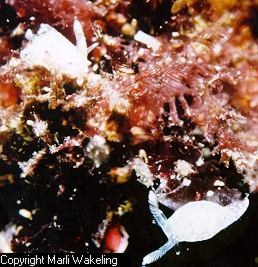
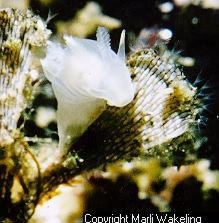
Hi Bill,
I'm getting with the electronic age and have learned to scan photos, so I thought I'd send you some B.C. species, [British Columbia, Canada] as suggested. Your site is down, so if they are things you already have on site, forgive! A little description will be included.
These are the nudibranchs thought to be Ancula pacifica, or Ancula gibbosa.
They were found in Howe Sound, British Columbia, but I have also found the
colourless ones on the Sechelt Penninsula and on Vancouver Island, also in B.C. All were found near hydroids and bryzoans, in about 45-60 feet.
I will also send you some others shortly.
Regards,
Marli Wakeling
President, 2000
Underwater British Columbia Photographic Society
scubamarli@excite.com
Wakeling, M., 2000 (Jun 3) Photos from British Columbia. [Message in] Sea Slug Forum. Australian Museum, Sydney. Available from http://www.seaslugforum.net/find/2495Dear Marli,
Thanks for these photos, and the others which have also arrived. Don't worry about duplication as it is very useful to have multiple photos of the same species to show differences in colour and to confirm identifications.
Sorry the site was down for 24 hours - much shorter than we thought it would be. Hopefully the site will now be much faster than over the last few months.
Best wishes,
Bill Rudman.
Ancula gibbosa white-spotted version
May 28, 2000
From: Marli Wakeling
Hi,
I too have just found the white-spotted version of this animal, near Vancouver, B.C., in Canada. It was found with uncoloured specimens at 40 feet near bryzoans, laying eggs in a thin, small oval. Size was 0.5 cm. I also found the uncoloured ones several hundred miles north, at Egmont, B.C. Donna Gibbs has sent specimens for evaluation to Dave Behrens. Has anyone actually dissected one of these to determine it is the same species, as the colouration (at least of the spotted one is so different)?
Regards,
Marli Wakeling
Vancouver,B.C.
scubamarli@excite.com
Wakeling, M., 2000 (May 28) Ancula gibbosa white-spotted version. [Message in] Sea Slug Forum. Australian Museum, Sydney. Available from http://www.seaslugforum.net/find/2462Dear Marli,
Welcome to the Forum. I am sure if anyone has had a look at their anatomy they will let us know.
Best wishes,
Bill Rudman.
Ancula gibbosa colour variety
May 19, 2000
From: Sandra Millen

Concerning the earlier discussion on Ancula gibbosa and A. pacifica. I have always felt that Ancula pacifica MacFarland, 1905 was the same species as A. gibbosa (Risso, 1818). Gary McDonald (1983) has discussed how similar they are except for yellow lines on the body of A. pacifica which are often discontinuous. In British Columbia and Alaska, the yellow lines are absent altogether. I am sending a photo of yet another colour variety, with white spots. These spotted animals are usually seen crawling on mud bottoms along with unspotted specimens. I have seen them several times near Vancouver, but did not have a good photo until now. This animal was spotted by Donna Gibbs of the Vancouver Aquarium and the photo taken by her husband Charlie. Charlie says "Donna has the ultimate in point and shoot photography, she points, I shoot".
Thanks to them both.
Sandra Millen
millen@zoology.ubc.ca
Millen, S., 2000 (May 19) Ancula gibbosa colour variety. [Message in] Sea Slug Forum. Australian Museum, Sydney. Available from http://www.seaslugforum.net/find/2404Dear Sandra,
Thanks for sharing this beautiful photo and another colour form. all we need now is the 'typical' form with orange. Donna has definitely developed a superb photographic method.
Bill Rudman.
Differences between species of Ancula
March 26, 2000
From: Sylvain LE BRIS
Hi
I would like to know if Ancula pacifica from Alaska to California and Ancula gibbosa from the British Isles are the same species ?
Thanks,
Sylvain LE BRIS
lebris@com.univ-mrs.fr
LE BRIS, S., 2000 (Mar 26) Differences between species of Ancula. [Message in] Sea Slug Forum. Australian Museum, Sydney. Available from http://www.seaslugforum.net/find/1958Dear Sylvain,
I am not sure if they are or not. Thompson thought they were but I can't find any other authors who say the same. The European animal has both white and an orange lined colour forms and the orange one seems identical in colour to the A. pacifica. Perhaps someone from the American west coast can give us their opinion.
Ancula pacifica, Macfarland, 1905 from the west coast of North America is white with three yellow lines running along the body and the rhinophores, gills and extra appendages have an apical yellow band. I think there are records from Japan as well.
A. gibbosa (Risso, 1818) is reported from the western Mediterranean around the northern Atlantic coast to the White Sea, Greenland & Iceland and across the New England coast of N. America. Thompson (1976) describes it as white with yellow capped rhinophores, gills and extra appendages, but does not mention yellow/ornage longitudinal lines. He synonymises Ancula pacifica with this species.
Photos of both species are available on websites. See Erwin Koehler's list at : http://www.medslugs.de/Opi/Opisthobranchia.htm
Best wishes,
Bill Rudman.
